University Assignment: Developing Literacy - Program Comparison Essay
VerifiedAdded on 2021/09/30
|12
|3070
|77
Essay
AI Summary
This essay provides a comprehensive comparison between integrated and stand-alone literacy programs, focusing on their approaches, components, and outcomes. It delves into the SRA FLEX literacy program, highlighting its digital, small group, and project-based components, and its effectiveness in addressing behavioral challenges and enhancing reading and writing skills, particularly for students struggling with reading. The essay contrasts this with the stand-alone literacy program, specifically the "Reading to Learn" program, which emphasizes individualized instruction and accelerated learning, catering to students of various ages and abilities. The comparison extends to the programs' implementation, teaching tools, and monitoring methods, as well as their impact on developing skills like reading, writing, communication, and critical thinking. Furthermore, the essay acknowledges other literacy programs like RAILS and Direct Instruction, emphasizing the importance of selecting programs that best suit individual student needs and educational goals. The essay concludes by summarizing the distinct advantages of each approach, offering valuable insights for educators to enhance their teaching strategies and improve student outcomes.
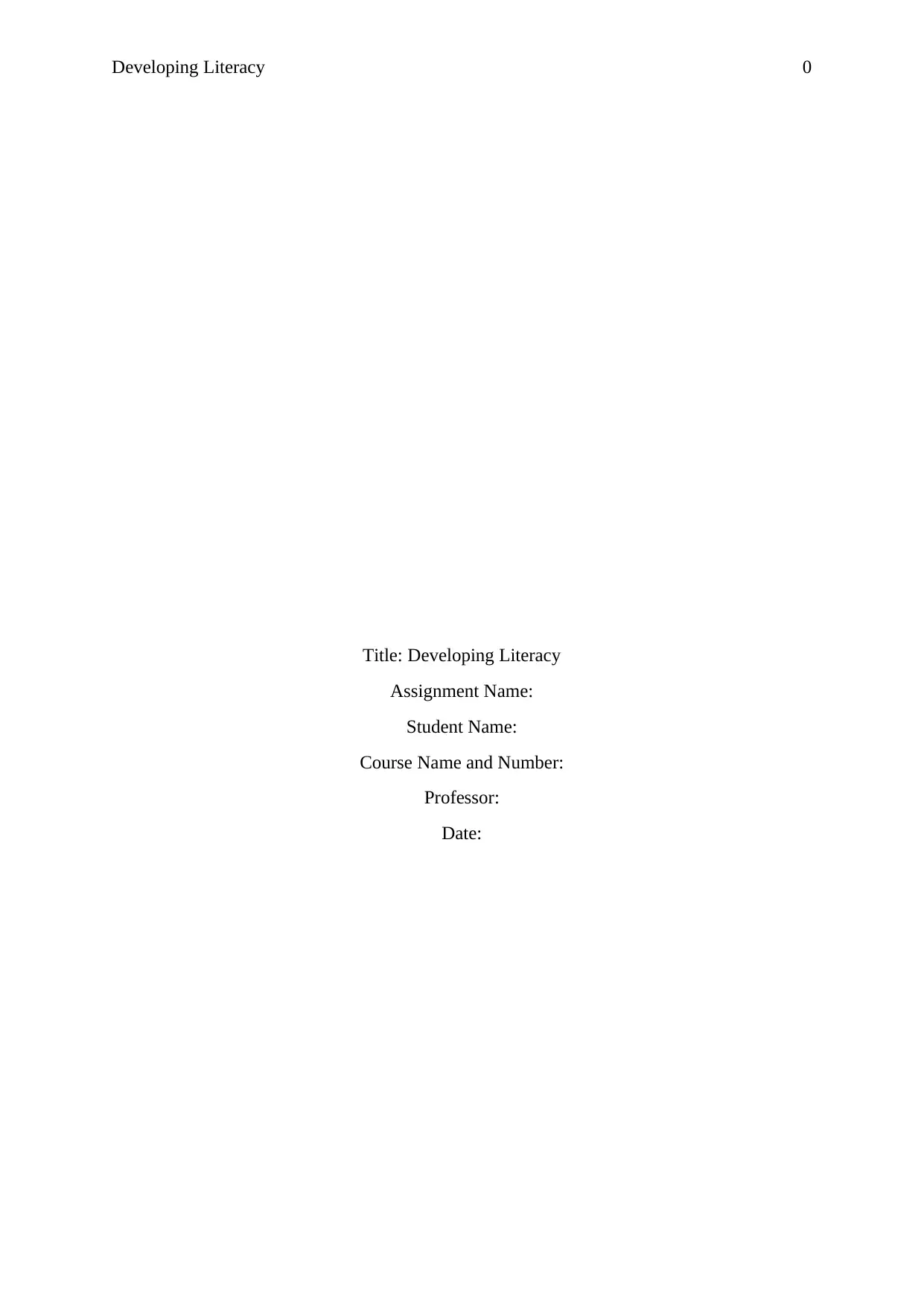
Developing Literacy 0
Title: Developing Literacy
Assignment Name:
Student Name:
Course Name and Number:
Professor:
Date:
Title: Developing Literacy
Assignment Name:
Student Name:
Course Name and Number:
Professor:
Date:
Paraphrase This Document
Need a fresh take? Get an instant paraphrase of this document with our AI Paraphraser
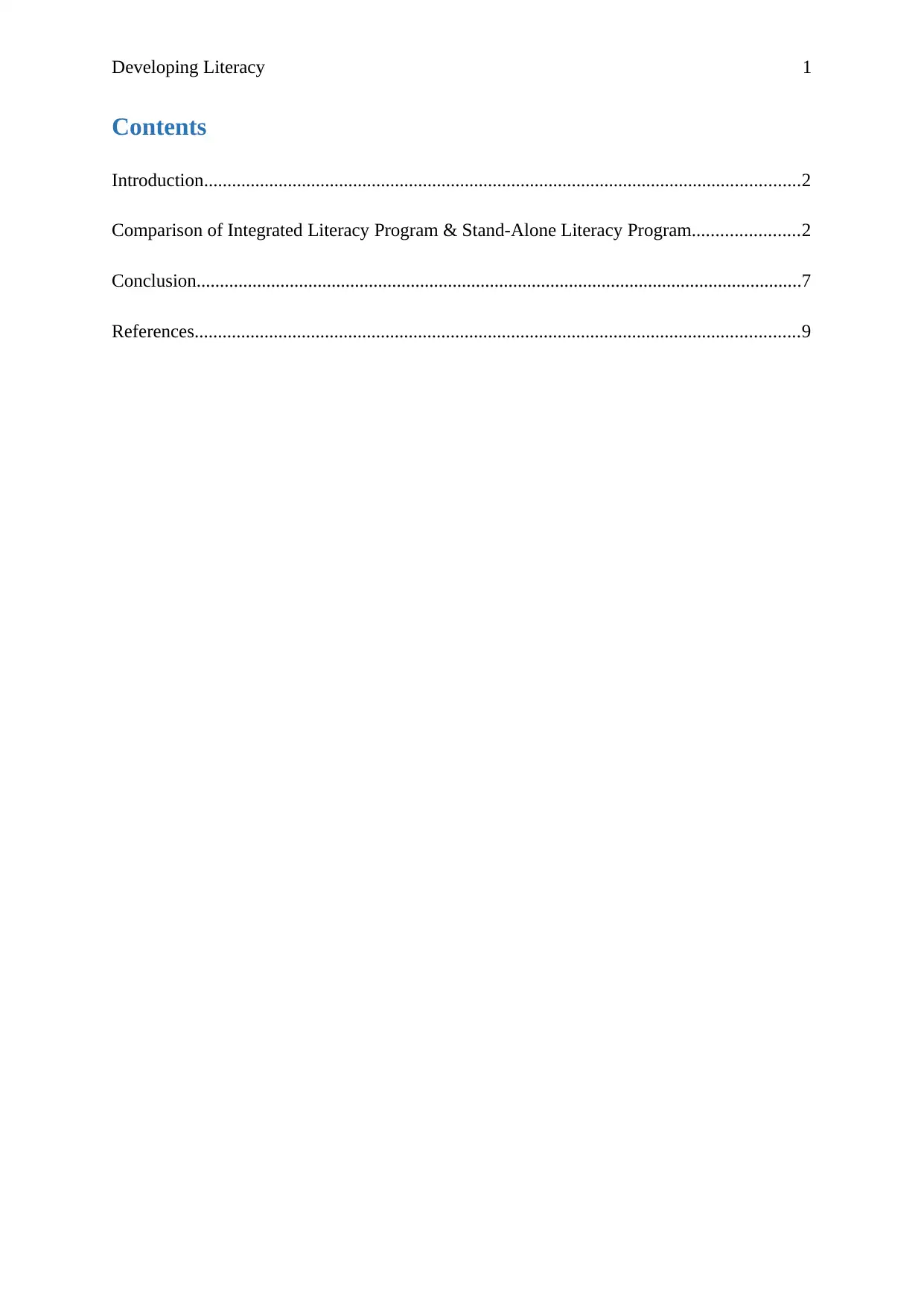
Developing Literacy 1
Contents
Introduction................................................................................................................................2
Comparison of Integrated Literacy Program & Stand-Alone Literacy Program.......................2
Conclusion..................................................................................................................................7
References..................................................................................................................................9
Contents
Introduction................................................................................................................................2
Comparison of Integrated Literacy Program & Stand-Alone Literacy Program.......................2
Conclusion..................................................................................................................................7
References..................................................................................................................................9
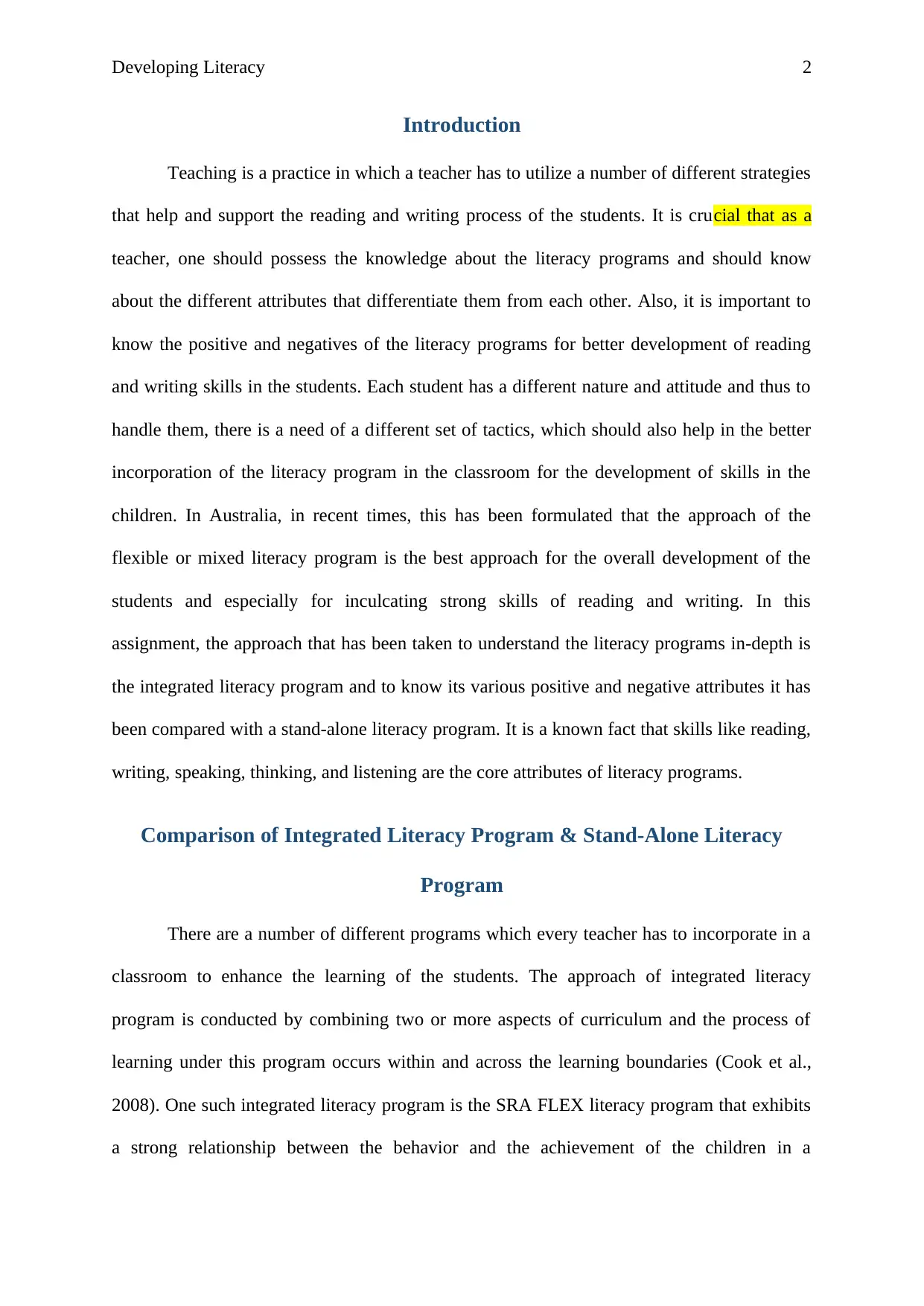
Developing Literacy 2
Introduction
Teaching is a practice in which a teacher has to utilize a number of different strategies
that help and support the reading and writing process of the students. It is crucial that as a
teacher, one should possess the knowledge about the literacy programs and should know
about the different attributes that differentiate them from each other. Also, it is important to
know the positive and negatives of the literacy programs for better development of reading
and writing skills in the students. Each student has a different nature and attitude and thus to
handle them, there is a need of a different set of tactics, which should also help in the better
incorporation of the literacy program in the classroom for the development of skills in the
children. In Australia, in recent times, this has been formulated that the approach of the
flexible or mixed literacy program is the best approach for the overall development of the
students and especially for inculcating strong skills of reading and writing. In this
assignment, the approach that has been taken to understand the literacy programs in-depth is
the integrated literacy program and to know its various positive and negative attributes it has
been compared with a stand-alone literacy program. It is a known fact that skills like reading,
writing, speaking, thinking, and listening are the core attributes of literacy programs.
Comparison of Integrated Literacy Program & Stand-Alone Literacy
Program
There are a number of different programs which every teacher has to incorporate in a
classroom to enhance the learning of the students. The approach of integrated literacy
program is conducted by combining two or more aspects of curriculum and the process of
learning under this program occurs within and across the learning boundaries (Cook et al.,
2008). One such integrated literacy program is the SRA FLEX literacy program that exhibits
a strong relationship between the behavior and the achievement of the children in a
Introduction
Teaching is a practice in which a teacher has to utilize a number of different strategies
that help and support the reading and writing process of the students. It is crucial that as a
teacher, one should possess the knowledge about the literacy programs and should know
about the different attributes that differentiate them from each other. Also, it is important to
know the positive and negatives of the literacy programs for better development of reading
and writing skills in the students. Each student has a different nature and attitude and thus to
handle them, there is a need of a different set of tactics, which should also help in the better
incorporation of the literacy program in the classroom for the development of skills in the
children. In Australia, in recent times, this has been formulated that the approach of the
flexible or mixed literacy program is the best approach for the overall development of the
students and especially for inculcating strong skills of reading and writing. In this
assignment, the approach that has been taken to understand the literacy programs in-depth is
the integrated literacy program and to know its various positive and negative attributes it has
been compared with a stand-alone literacy program. It is a known fact that skills like reading,
writing, speaking, thinking, and listening are the core attributes of literacy programs.
Comparison of Integrated Literacy Program & Stand-Alone Literacy
Program
There are a number of different programs which every teacher has to incorporate in a
classroom to enhance the learning of the students. The approach of integrated literacy
program is conducted by combining two or more aspects of curriculum and the process of
learning under this program occurs within and across the learning boundaries (Cook et al.,
2008). One such integrated literacy program is the SRA FLEX literacy program that exhibits
a strong relationship between the behavior and the achievement of the children in a
⊘ This is a preview!⊘
Do you want full access?
Subscribe today to unlock all pages.

Trusted by 1+ million students worldwide
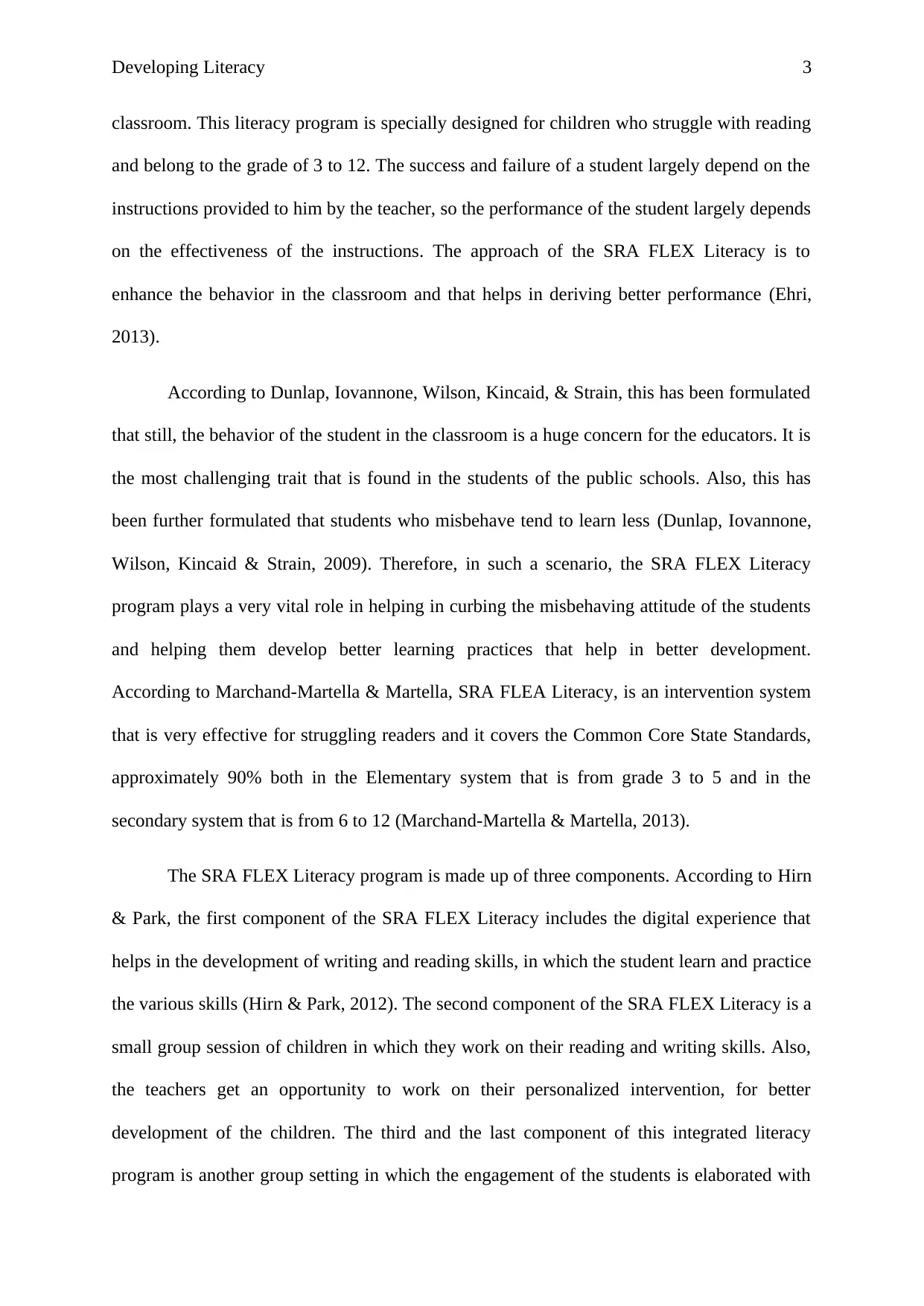
Developing Literacy 3
classroom. This literacy program is specially designed for children who struggle with reading
and belong to the grade of 3 to 12. The success and failure of a student largely depend on the
instructions provided to him by the teacher, so the performance of the student largely depends
on the effectiveness of the instructions. The approach of the SRA FLEX Literacy is to
enhance the behavior in the classroom and that helps in deriving better performance (Ehri,
2013).
According to Dunlap, Iovannone, Wilson, Kincaid, & Strain, this has been formulated
that still, the behavior of the student in the classroom is a huge concern for the educators. It is
the most challenging trait that is found in the students of the public schools. Also, this has
been further formulated that students who misbehave tend to learn less (Dunlap, Iovannone,
Wilson, Kincaid & Strain, 2009). Therefore, in such a scenario, the SRA FLEX Literacy
program plays a very vital role in helping in curbing the misbehaving attitude of the students
and helping them develop better learning practices that help in better development.
According to Marchand-Martella & Martella, SRA FLEA Literacy, is an intervention system
that is very effective for struggling readers and it covers the Common Core State Standards,
approximately 90% both in the Elementary system that is from grade 3 to 5 and in the
secondary system that is from 6 to 12 (Marchand-Martella & Martella, 2013).
The SRA FLEX Literacy program is made up of three components. According to Hirn
& Park, the first component of the SRA FLEX Literacy includes the digital experience that
helps in the development of writing and reading skills, in which the student learn and practice
the various skills (Hirn & Park, 2012). The second component of the SRA FLEX Literacy is a
small group session of children in which they work on their reading and writing skills. Also,
the teachers get an opportunity to work on their personalized intervention, for better
development of the children. The third and the last component of this integrated literacy
program is another group setting in which the engagement of the students is elaborated with
classroom. This literacy program is specially designed for children who struggle with reading
and belong to the grade of 3 to 12. The success and failure of a student largely depend on the
instructions provided to him by the teacher, so the performance of the student largely depends
on the effectiveness of the instructions. The approach of the SRA FLEX Literacy is to
enhance the behavior in the classroom and that helps in deriving better performance (Ehri,
2013).
According to Dunlap, Iovannone, Wilson, Kincaid, & Strain, this has been formulated
that still, the behavior of the student in the classroom is a huge concern for the educators. It is
the most challenging trait that is found in the students of the public schools. Also, this has
been further formulated that students who misbehave tend to learn less (Dunlap, Iovannone,
Wilson, Kincaid & Strain, 2009). Therefore, in such a scenario, the SRA FLEX Literacy
program plays a very vital role in helping in curbing the misbehaving attitude of the students
and helping them develop better learning practices that help in better development.
According to Marchand-Martella & Martella, SRA FLEA Literacy, is an intervention system
that is very effective for struggling readers and it covers the Common Core State Standards,
approximately 90% both in the Elementary system that is from grade 3 to 5 and in the
secondary system that is from 6 to 12 (Marchand-Martella & Martella, 2013).
The SRA FLEX Literacy program is made up of three components. According to Hirn
& Park, the first component of the SRA FLEX Literacy includes the digital experience that
helps in the development of writing and reading skills, in which the student learn and practice
the various skills (Hirn & Park, 2012). The second component of the SRA FLEX Literacy is a
small group session of children in which they work on their reading and writing skills. Also,
the teachers get an opportunity to work on their personalized intervention, for better
development of the children. The third and the last component of this integrated literacy
program is another group setting in which the engagement of the students is elaborated with
Paraphrase This Document
Need a fresh take? Get an instant paraphrase of this document with our AI Paraphraser
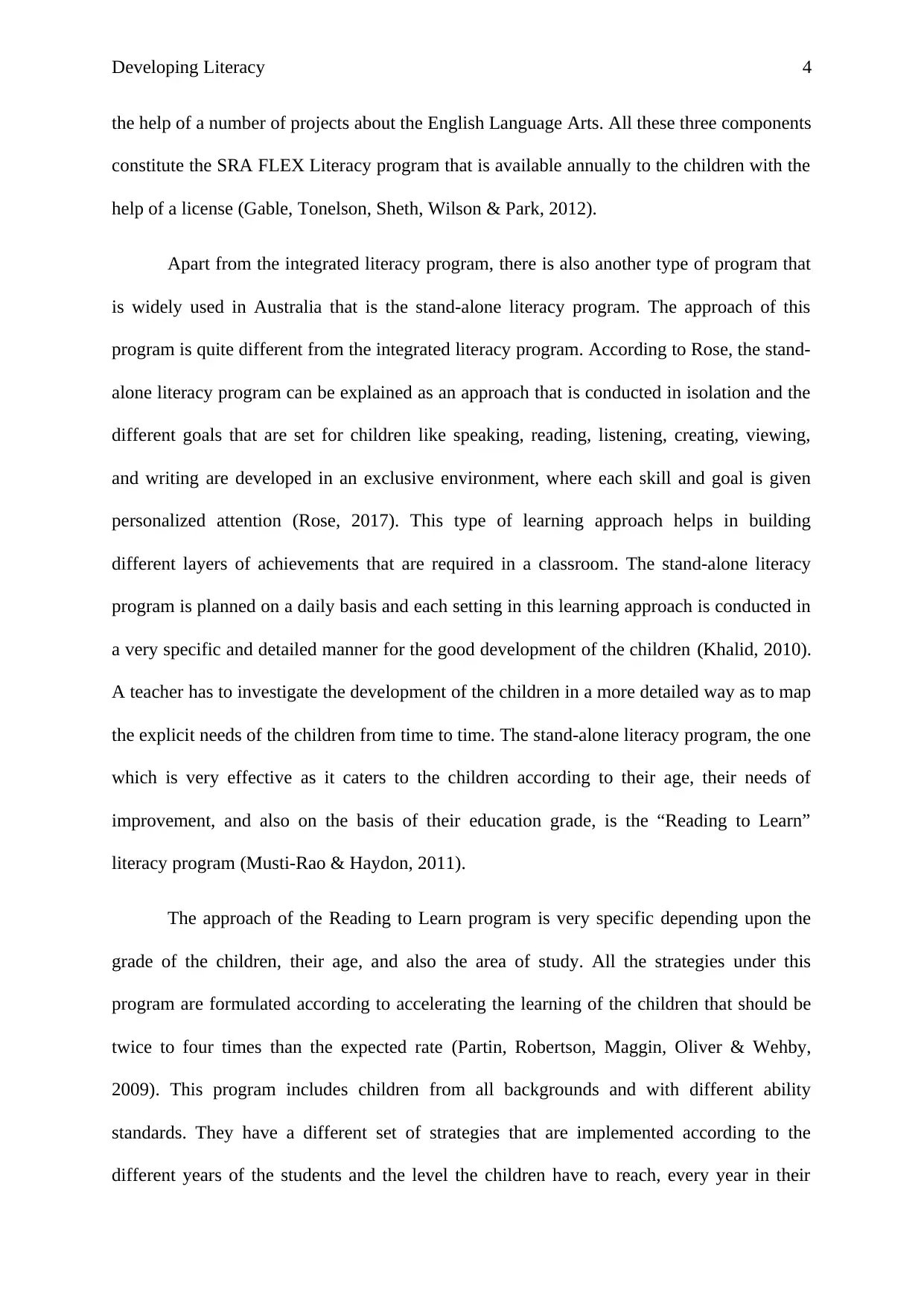
Developing Literacy 4
the help of a number of projects about the English Language Arts. All these three components
constitute the SRA FLEX Literacy program that is available annually to the children with the
help of a license (Gable, Tonelson, Sheth, Wilson & Park, 2012).
Apart from the integrated literacy program, there is also another type of program that
is widely used in Australia that is the stand-alone literacy program. The approach of this
program is quite different from the integrated literacy program. According to Rose, the stand-
alone literacy program can be explained as an approach that is conducted in isolation and the
different goals that are set for children like speaking, reading, listening, creating, viewing,
and writing are developed in an exclusive environment, where each skill and goal is given
personalized attention (Rose, 2017). This type of learning approach helps in building
different layers of achievements that are required in a classroom. The stand-alone literacy
program is planned on a daily basis and each setting in this learning approach is conducted in
a very specific and detailed manner for the good development of the children (Khalid, 2010).
A teacher has to investigate the development of the children in a more detailed way as to map
the explicit needs of the children from time to time. The stand-alone literacy program, the one
which is very effective as it caters to the children according to their age, their needs of
improvement, and also on the basis of their education grade, is the “Reading to Learn”
literacy program (Musti-Rao & Haydon, 2011).
The approach of the Reading to Learn program is very specific depending upon the
grade of the children, their age, and also the area of study. All the strategies under this
program are formulated according to accelerating the learning of the children that should be
twice to four times than the expected rate (Partin, Robertson, Maggin, Oliver & Wehby,
2009). This program includes children from all backgrounds and with different ability
standards. They have a different set of strategies that are implemented according to the
different years of the students and the level the children have to reach, every year in their
the help of a number of projects about the English Language Arts. All these three components
constitute the SRA FLEX Literacy program that is available annually to the children with the
help of a license (Gable, Tonelson, Sheth, Wilson & Park, 2012).
Apart from the integrated literacy program, there is also another type of program that
is widely used in Australia that is the stand-alone literacy program. The approach of this
program is quite different from the integrated literacy program. According to Rose, the stand-
alone literacy program can be explained as an approach that is conducted in isolation and the
different goals that are set for children like speaking, reading, listening, creating, viewing,
and writing are developed in an exclusive environment, where each skill and goal is given
personalized attention (Rose, 2017). This type of learning approach helps in building
different layers of achievements that are required in a classroom. The stand-alone literacy
program is planned on a daily basis and each setting in this learning approach is conducted in
a very specific and detailed manner for the good development of the children (Khalid, 2010).
A teacher has to investigate the development of the children in a more detailed way as to map
the explicit needs of the children from time to time. The stand-alone literacy program, the one
which is very effective as it caters to the children according to their age, their needs of
improvement, and also on the basis of their education grade, is the “Reading to Learn”
literacy program (Musti-Rao & Haydon, 2011).
The approach of the Reading to Learn program is very specific depending upon the
grade of the children, their age, and also the area of study. All the strategies under this
program are formulated according to accelerating the learning of the children that should be
twice to four times than the expected rate (Partin, Robertson, Maggin, Oliver & Wehby,
2009). This program includes children from all backgrounds and with different ability
standards. They have a different set of strategies that are implemented according to the
different years of the students and the level the children have to reach, every year in their
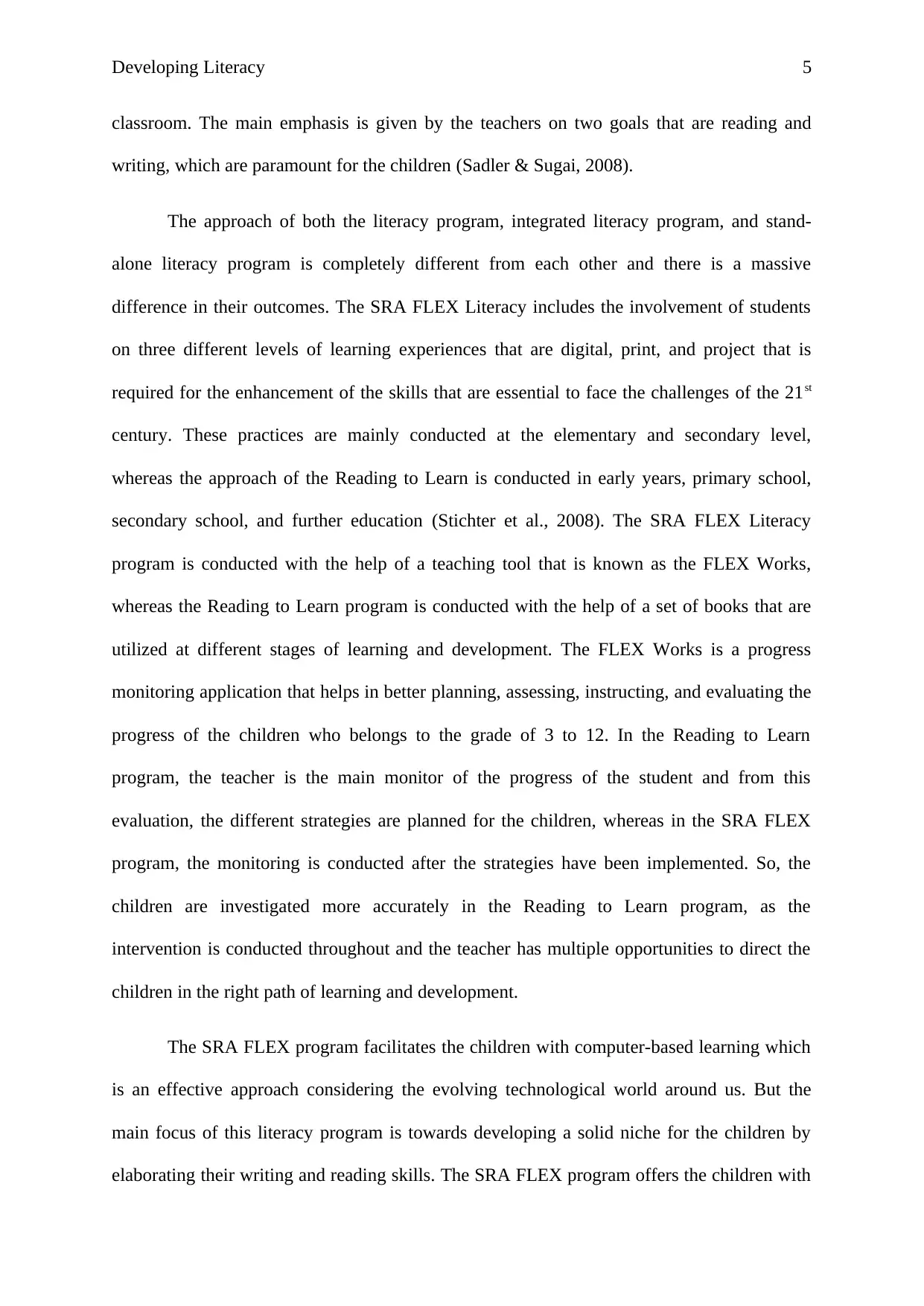
Developing Literacy 5
classroom. The main emphasis is given by the teachers on two goals that are reading and
writing, which are paramount for the children (Sadler & Sugai, 2008).
The approach of both the literacy program, integrated literacy program, and stand-
alone literacy program is completely different from each other and there is a massive
difference in their outcomes. The SRA FLEX Literacy includes the involvement of students
on three different levels of learning experiences that are digital, print, and project that is
required for the enhancement of the skills that are essential to face the challenges of the 21st
century. These practices are mainly conducted at the elementary and secondary level,
whereas the approach of the Reading to Learn is conducted in early years, primary school,
secondary school, and further education (Stichter et al., 2008). The SRA FLEX Literacy
program is conducted with the help of a teaching tool that is known as the FLEX Works,
whereas the Reading to Learn program is conducted with the help of a set of books that are
utilized at different stages of learning and development. The FLEX Works is a progress
monitoring application that helps in better planning, assessing, instructing, and evaluating the
progress of the children who belongs to the grade of 3 to 12. In the Reading to Learn
program, the teacher is the main monitor of the progress of the student and from this
evaluation, the different strategies are planned for the children, whereas in the SRA FLEX
program, the monitoring is conducted after the strategies have been implemented. So, the
children are investigated more accurately in the Reading to Learn program, as the
intervention is conducted throughout and the teacher has multiple opportunities to direct the
children in the right path of learning and development.
The SRA FLEX program facilitates the children with computer-based learning which
is an effective approach considering the evolving technological world around us. But the
main focus of this literacy program is towards developing a solid niche for the children by
elaborating their writing and reading skills. The SRA FLEX program offers the children with
classroom. The main emphasis is given by the teachers on two goals that are reading and
writing, which are paramount for the children (Sadler & Sugai, 2008).
The approach of both the literacy program, integrated literacy program, and stand-
alone literacy program is completely different from each other and there is a massive
difference in their outcomes. The SRA FLEX Literacy includes the involvement of students
on three different levels of learning experiences that are digital, print, and project that is
required for the enhancement of the skills that are essential to face the challenges of the 21st
century. These practices are mainly conducted at the elementary and secondary level,
whereas the approach of the Reading to Learn is conducted in early years, primary school,
secondary school, and further education (Stichter et al., 2008). The SRA FLEX Literacy
program is conducted with the help of a teaching tool that is known as the FLEX Works,
whereas the Reading to Learn program is conducted with the help of a set of books that are
utilized at different stages of learning and development. The FLEX Works is a progress
monitoring application that helps in better planning, assessing, instructing, and evaluating the
progress of the children who belongs to the grade of 3 to 12. In the Reading to Learn
program, the teacher is the main monitor of the progress of the student and from this
evaluation, the different strategies are planned for the children, whereas in the SRA FLEX
program, the monitoring is conducted after the strategies have been implemented. So, the
children are investigated more accurately in the Reading to Learn program, as the
intervention is conducted throughout and the teacher has multiple opportunities to direct the
children in the right path of learning and development.
The SRA FLEX program facilitates the children with computer-based learning which
is an effective approach considering the evolving technological world around us. But the
main focus of this literacy program is towards developing a solid niche for the children by
elaborating their writing and reading skills. The SRA FLEX program offers the children with
⊘ This is a preview!⊘
Do you want full access?
Subscribe today to unlock all pages.

Trusted by 1+ million students worldwide
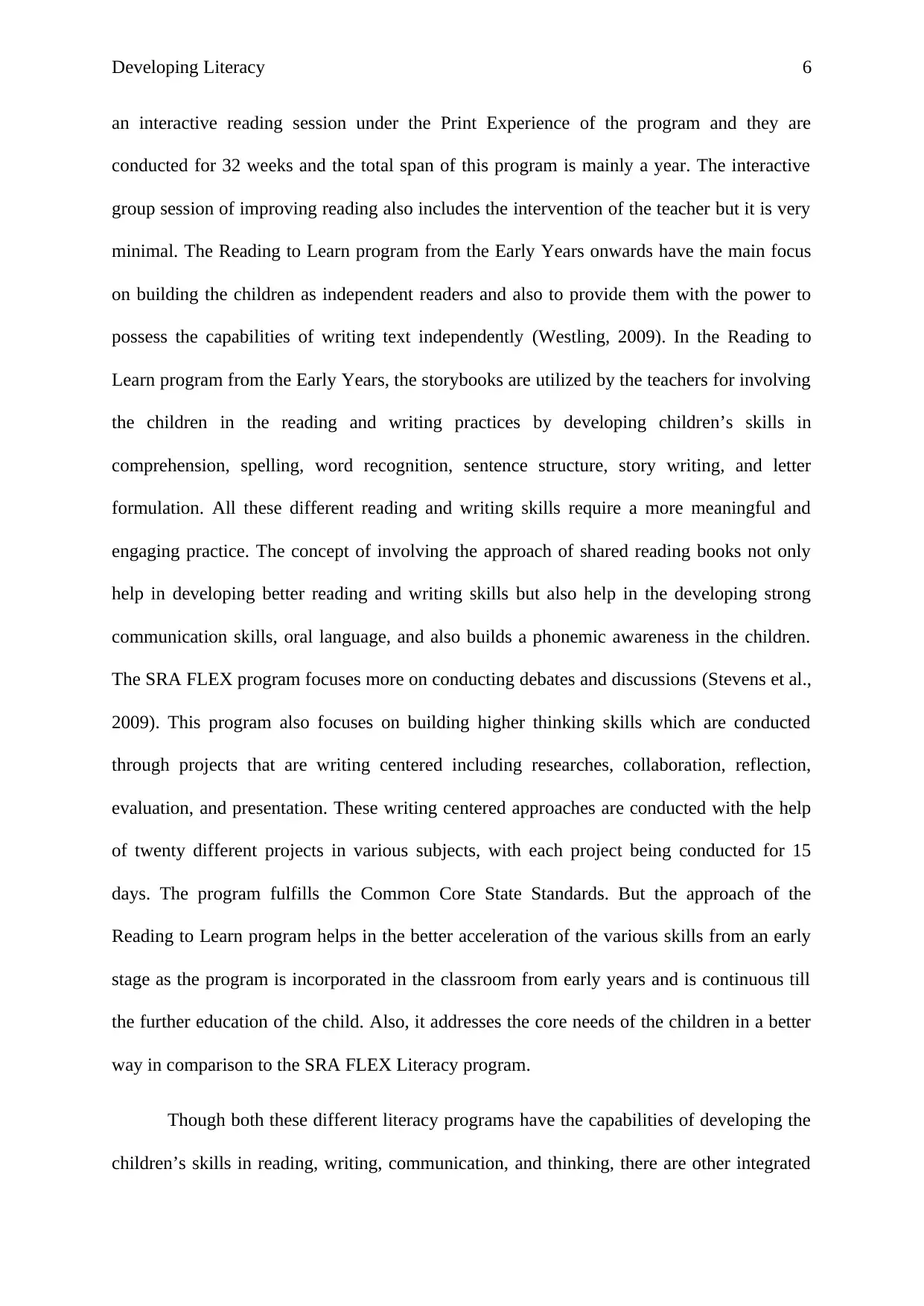
Developing Literacy 6
an interactive reading session under the Print Experience of the program and they are
conducted for 32 weeks and the total span of this program is mainly a year. The interactive
group session of improving reading also includes the intervention of the teacher but it is very
minimal. The Reading to Learn program from the Early Years onwards have the main focus
on building the children as independent readers and also to provide them with the power to
possess the capabilities of writing text independently (Westling, 2009). In the Reading to
Learn program from the Early Years, the storybooks are utilized by the teachers for involving
the children in the reading and writing practices by developing children’s skills in
comprehension, spelling, word recognition, sentence structure, story writing, and letter
formulation. All these different reading and writing skills require a more meaningful and
engaging practice. The concept of involving the approach of shared reading books not only
help in developing better reading and writing skills but also help in the developing strong
communication skills, oral language, and also builds a phonemic awareness in the children.
The SRA FLEX program focuses more on conducting debates and discussions (Stevens et al.,
2009). This program also focuses on building higher thinking skills which are conducted
through projects that are writing centered including researches, collaboration, reflection,
evaluation, and presentation. These writing centered approaches are conducted with the help
of twenty different projects in various subjects, with each project being conducted for 15
days. The program fulfills the Common Core State Standards. But the approach of the
Reading to Learn program helps in the better acceleration of the various skills from an early
stage as the program is incorporated in the classroom from early years and is continuous till
the further education of the child. Also, it addresses the core needs of the children in a better
way in comparison to the SRA FLEX Literacy program.
Though both these different literacy programs have the capabilities of developing the
children’s skills in reading, writing, communication, and thinking, there are other integrated
an interactive reading session under the Print Experience of the program and they are
conducted for 32 weeks and the total span of this program is mainly a year. The interactive
group session of improving reading also includes the intervention of the teacher but it is very
minimal. The Reading to Learn program from the Early Years onwards have the main focus
on building the children as independent readers and also to provide them with the power to
possess the capabilities of writing text independently (Westling, 2009). In the Reading to
Learn program from the Early Years, the storybooks are utilized by the teachers for involving
the children in the reading and writing practices by developing children’s skills in
comprehension, spelling, word recognition, sentence structure, story writing, and letter
formulation. All these different reading and writing skills require a more meaningful and
engaging practice. The concept of involving the approach of shared reading books not only
help in developing better reading and writing skills but also help in the developing strong
communication skills, oral language, and also builds a phonemic awareness in the children.
The SRA FLEX program focuses more on conducting debates and discussions (Stevens et al.,
2009). This program also focuses on building higher thinking skills which are conducted
through projects that are writing centered including researches, collaboration, reflection,
evaluation, and presentation. These writing centered approaches are conducted with the help
of twenty different projects in various subjects, with each project being conducted for 15
days. The program fulfills the Common Core State Standards. But the approach of the
Reading to Learn program helps in the better acceleration of the various skills from an early
stage as the program is incorporated in the classroom from early years and is continuous till
the further education of the child. Also, it addresses the core needs of the children in a better
way in comparison to the SRA FLEX Literacy program.
Though both these different literacy programs have the capabilities of developing the
children’s skills in reading, writing, communication, and thinking, there are other integrated
Paraphrase This Document
Need a fresh take? Get an instant paraphrase of this document with our AI Paraphraser
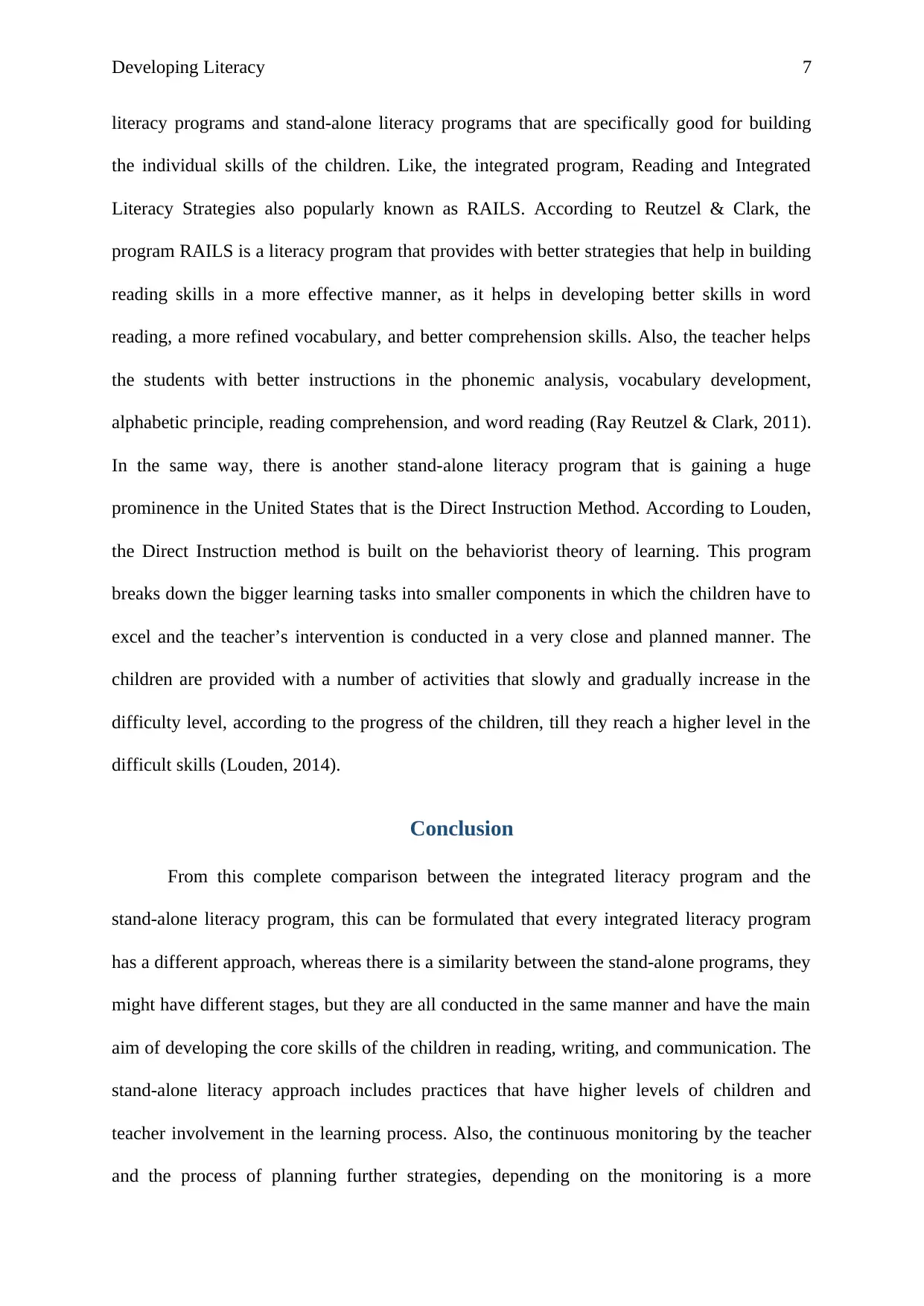
Developing Literacy 7
literacy programs and stand-alone literacy programs that are specifically good for building
the individual skills of the children. Like, the integrated program, Reading and Integrated
Literacy Strategies also popularly known as RAILS. According to Reutzel & Clark, the
program RAILS is a literacy program that provides with better strategies that help in building
reading skills in a more effective manner, as it helps in developing better skills in word
reading, a more refined vocabulary, and better comprehension skills. Also, the teacher helps
the students with better instructions in the phonemic analysis, vocabulary development,
alphabetic principle, reading comprehension, and word reading (Ray Reutzel & Clark, 2011).
In the same way, there is another stand-alone literacy program that is gaining a huge
prominence in the United States that is the Direct Instruction Method. According to Louden,
the Direct Instruction method is built on the behaviorist theory of learning. This program
breaks down the bigger learning tasks into smaller components in which the children have to
excel and the teacher’s intervention is conducted in a very close and planned manner. The
children are provided with a number of activities that slowly and gradually increase in the
difficulty level, according to the progress of the children, till they reach a higher level in the
difficult skills (Louden, 2014).
Conclusion
From this complete comparison between the integrated literacy program and the
stand-alone literacy program, this can be formulated that every integrated literacy program
has a different approach, whereas there is a similarity between the stand-alone programs, they
might have different stages, but they are all conducted in the same manner and have the main
aim of developing the core skills of the children in reading, writing, and communication. The
stand-alone literacy approach includes practices that have higher levels of children and
teacher involvement in the learning process. Also, the continuous monitoring by the teacher
and the process of planning further strategies, depending on the monitoring is a more
literacy programs and stand-alone literacy programs that are specifically good for building
the individual skills of the children. Like, the integrated program, Reading and Integrated
Literacy Strategies also popularly known as RAILS. According to Reutzel & Clark, the
program RAILS is a literacy program that provides with better strategies that help in building
reading skills in a more effective manner, as it helps in developing better skills in word
reading, a more refined vocabulary, and better comprehension skills. Also, the teacher helps
the students with better instructions in the phonemic analysis, vocabulary development,
alphabetic principle, reading comprehension, and word reading (Ray Reutzel & Clark, 2011).
In the same way, there is another stand-alone literacy program that is gaining a huge
prominence in the United States that is the Direct Instruction Method. According to Louden,
the Direct Instruction method is built on the behaviorist theory of learning. This program
breaks down the bigger learning tasks into smaller components in which the children have to
excel and the teacher’s intervention is conducted in a very close and planned manner. The
children are provided with a number of activities that slowly and gradually increase in the
difficulty level, according to the progress of the children, till they reach a higher level in the
difficult skills (Louden, 2014).
Conclusion
From this complete comparison between the integrated literacy program and the
stand-alone literacy program, this can be formulated that every integrated literacy program
has a different approach, whereas there is a similarity between the stand-alone programs, they
might have different stages, but they are all conducted in the same manner and have the main
aim of developing the core skills of the children in reading, writing, and communication. The
stand-alone literacy approach includes practices that have higher levels of children and
teacher involvement in the learning process. Also, the continuous monitoring by the teacher
and the process of planning further strategies, depending on the monitoring is a more
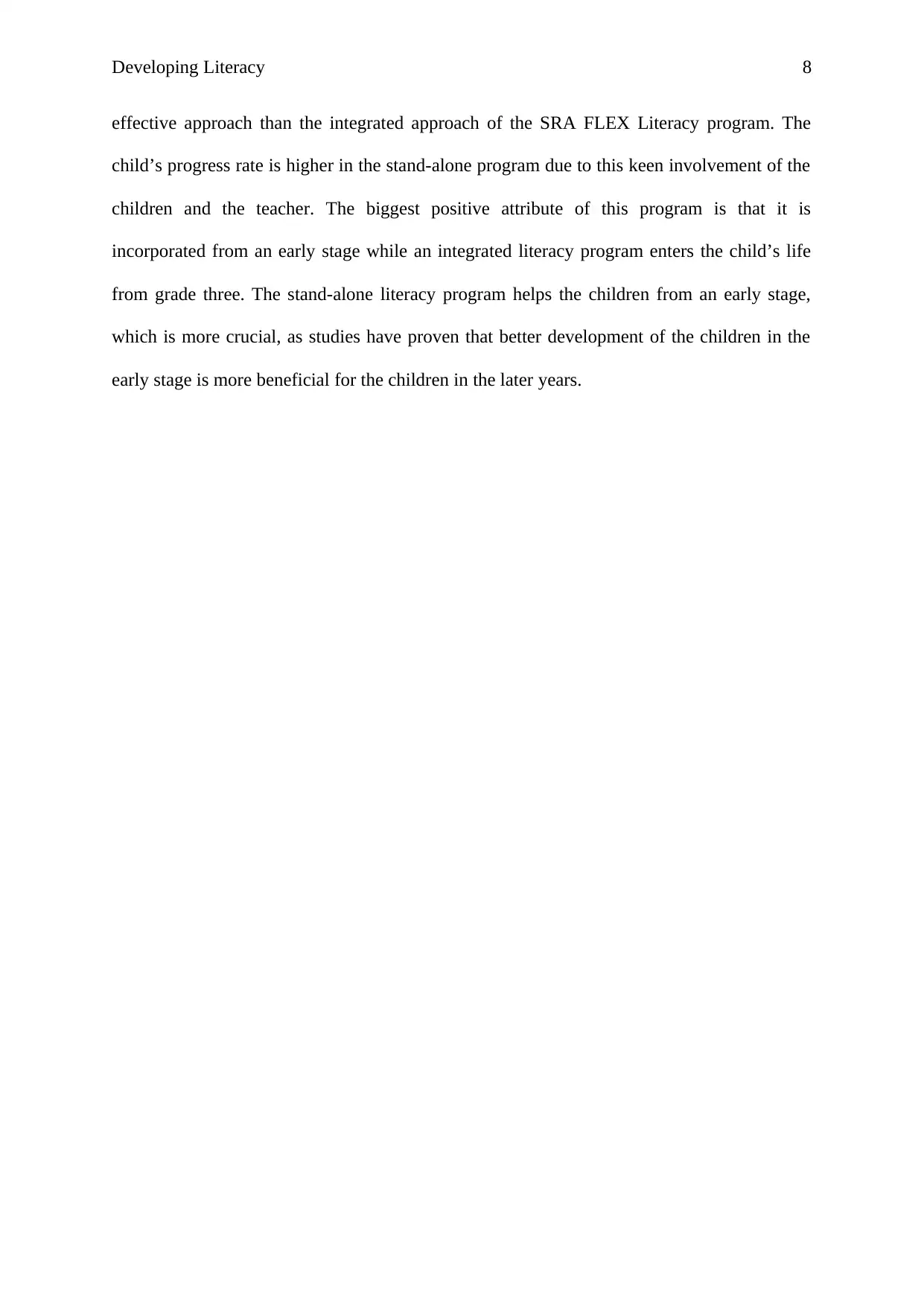
Developing Literacy 8
effective approach than the integrated approach of the SRA FLEX Literacy program. The
child’s progress rate is higher in the stand-alone program due to this keen involvement of the
children and the teacher. The biggest positive attribute of this program is that it is
incorporated from an early stage while an integrated literacy program enters the child’s life
from grade three. The stand-alone literacy program helps the children from an early stage,
which is more crucial, as studies have proven that better development of the children in the
early stage is more beneficial for the children in the later years.
effective approach than the integrated approach of the SRA FLEX Literacy program. The
child’s progress rate is higher in the stand-alone program due to this keen involvement of the
children and the teacher. The biggest positive attribute of this program is that it is
incorporated from an early stage while an integrated literacy program enters the child’s life
from grade three. The stand-alone literacy program helps the children from an early stage,
which is more crucial, as studies have proven that better development of the children in the
early stage is more beneficial for the children in the later years.
⊘ This is a preview!⊘
Do you want full access?
Subscribe today to unlock all pages.

Trusted by 1+ million students worldwide
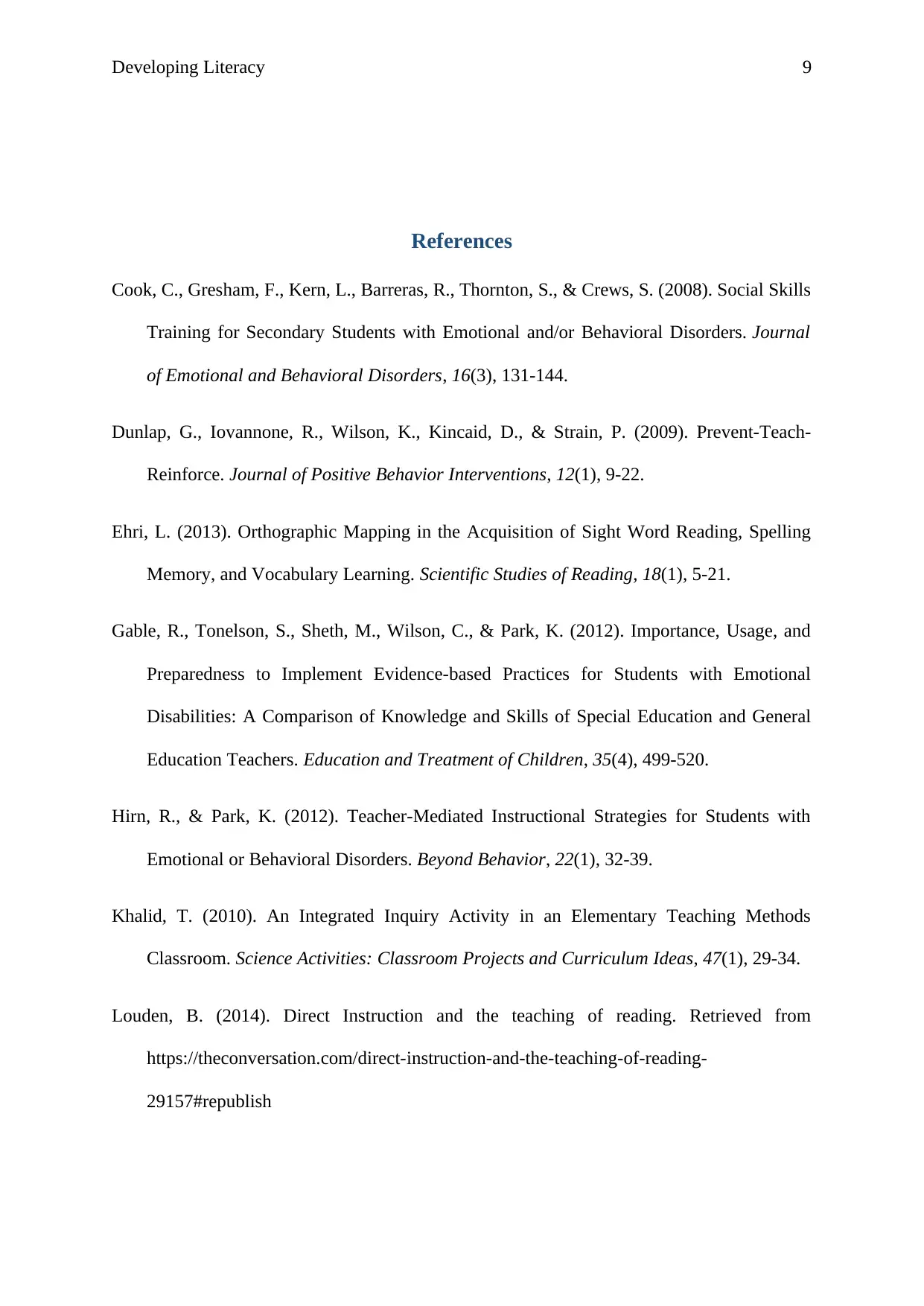
Developing Literacy 9
References
Cook, C., Gresham, F., Kern, L., Barreras, R., Thornton, S., & Crews, S. (2008). Social Skills
Training for Secondary Students with Emotional and/or Behavioral Disorders. Journal
of Emotional and Behavioral Disorders, 16(3), 131-144.
Dunlap, G., Iovannone, R., Wilson, K., Kincaid, D., & Strain, P. (2009). Prevent-Teach-
Reinforce. Journal of Positive Behavior Interventions, 12(1), 9-22.
Ehri, L. (2013). Orthographic Mapping in the Acquisition of Sight Word Reading, Spelling
Memory, and Vocabulary Learning. Scientific Studies of Reading, 18(1), 5-21.
Gable, R., Tonelson, S., Sheth, M., Wilson, C., & Park, K. (2012). Importance, Usage, and
Preparedness to Implement Evidence-based Practices for Students with Emotional
Disabilities: A Comparison of Knowledge and Skills of Special Education and General
Education Teachers. Education and Treatment of Children, 35(4), 499-520.
Hirn, R., & Park, K. (2012). Teacher-Mediated Instructional Strategies for Students with
Emotional or Behavioral Disorders. Beyond Behavior, 22(1), 32-39.
Khalid, T. (2010). An Integrated Inquiry Activity in an Elementary Teaching Methods
Classroom. Science Activities: Classroom Projects and Curriculum Ideas, 47(1), 29-34.
Louden, B. (2014). Direct Instruction and the teaching of reading. Retrieved from
https://theconversation.com/direct-instruction-and-the-teaching-of-reading-
29157#republish
References
Cook, C., Gresham, F., Kern, L., Barreras, R., Thornton, S., & Crews, S. (2008). Social Skills
Training for Secondary Students with Emotional and/or Behavioral Disorders. Journal
of Emotional and Behavioral Disorders, 16(3), 131-144.
Dunlap, G., Iovannone, R., Wilson, K., Kincaid, D., & Strain, P. (2009). Prevent-Teach-
Reinforce. Journal of Positive Behavior Interventions, 12(1), 9-22.
Ehri, L. (2013). Orthographic Mapping in the Acquisition of Sight Word Reading, Spelling
Memory, and Vocabulary Learning. Scientific Studies of Reading, 18(1), 5-21.
Gable, R., Tonelson, S., Sheth, M., Wilson, C., & Park, K. (2012). Importance, Usage, and
Preparedness to Implement Evidence-based Practices for Students with Emotional
Disabilities: A Comparison of Knowledge and Skills of Special Education and General
Education Teachers. Education and Treatment of Children, 35(4), 499-520.
Hirn, R., & Park, K. (2012). Teacher-Mediated Instructional Strategies for Students with
Emotional or Behavioral Disorders. Beyond Behavior, 22(1), 32-39.
Khalid, T. (2010). An Integrated Inquiry Activity in an Elementary Teaching Methods
Classroom. Science Activities: Classroom Projects and Curriculum Ideas, 47(1), 29-34.
Louden, B. (2014). Direct Instruction and the teaching of reading. Retrieved from
https://theconversation.com/direct-instruction-and-the-teaching-of-reading-
29157#republish
Paraphrase This Document
Need a fresh take? Get an instant paraphrase of this document with our AI Paraphraser
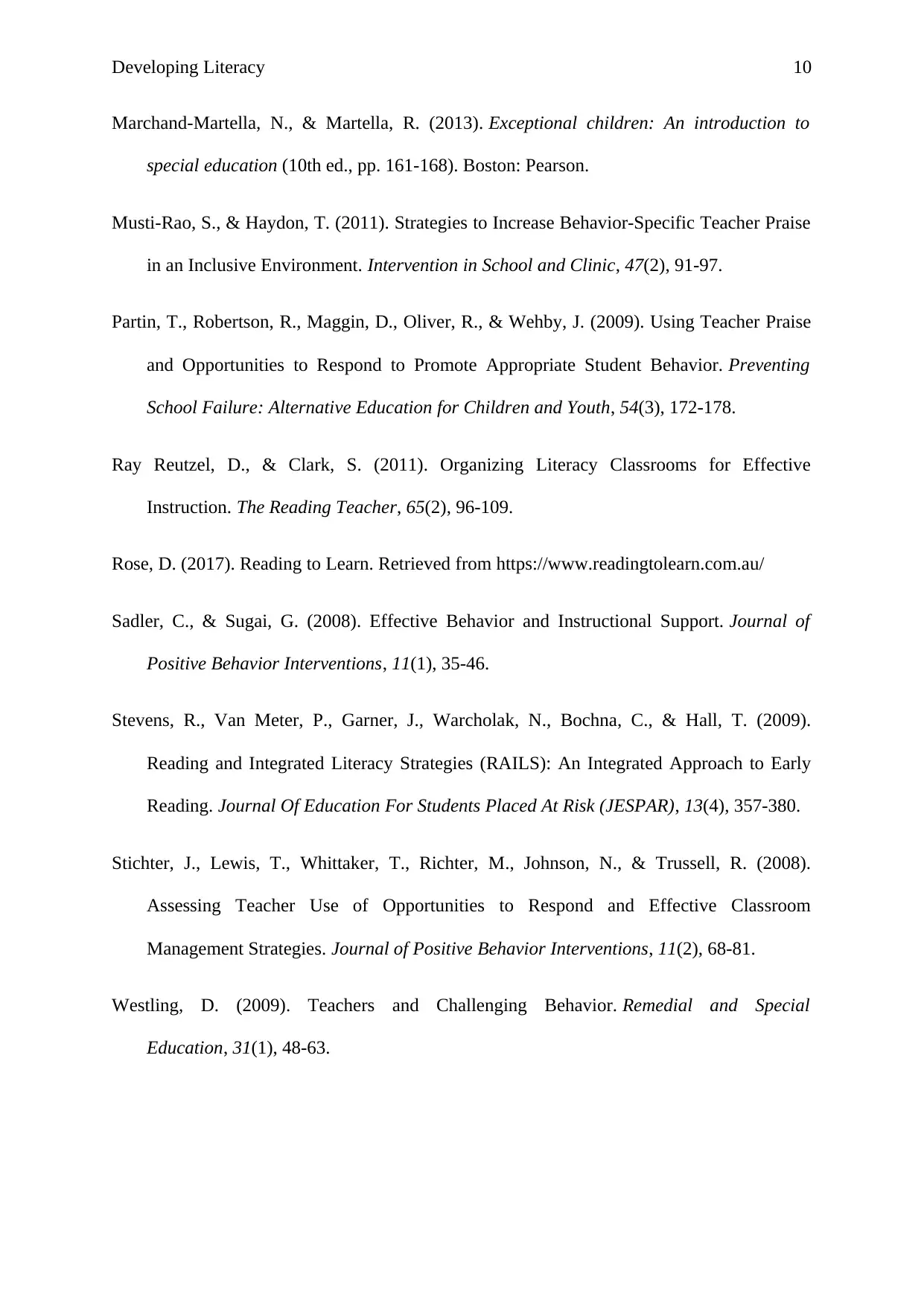
Developing Literacy 10
Marchand-Martella, N., & Martella, R. (2013). Exceptional children: An introduction to
special education (10th ed., pp. 161-168). Boston: Pearson.
Musti-Rao, S., & Haydon, T. (2011). Strategies to Increase Behavior-Specific Teacher Praise
in an Inclusive Environment. Intervention in School and Clinic, 47(2), 91-97.
Partin, T., Robertson, R., Maggin, D., Oliver, R., & Wehby, J. (2009). Using Teacher Praise
and Opportunities to Respond to Promote Appropriate Student Behavior. Preventing
School Failure: Alternative Education for Children and Youth, 54(3), 172-178.
Ray Reutzel, D., & Clark, S. (2011). Organizing Literacy Classrooms for Effective
Instruction. The Reading Teacher, 65(2), 96-109.
Rose, D. (2017). Reading to Learn. Retrieved from https://www.readingtolearn.com.au/
Sadler, C., & Sugai, G. (2008). Effective Behavior and Instructional Support. Journal of
Positive Behavior Interventions, 11(1), 35-46.
Stevens, R., Van Meter, P., Garner, J., Warcholak, N., Bochna, C., & Hall, T. (2009).
Reading and Integrated Literacy Strategies (RAILS): An Integrated Approach to Early
Reading. Journal Of Education For Students Placed At Risk (JESPAR), 13(4), 357-380.
Stichter, J., Lewis, T., Whittaker, T., Richter, M., Johnson, N., & Trussell, R. (2008).
Assessing Teacher Use of Opportunities to Respond and Effective Classroom
Management Strategies. Journal of Positive Behavior Interventions, 11(2), 68-81.
Westling, D. (2009). Teachers and Challenging Behavior. Remedial and Special
Education, 31(1), 48-63.
Marchand-Martella, N., & Martella, R. (2013). Exceptional children: An introduction to
special education (10th ed., pp. 161-168). Boston: Pearson.
Musti-Rao, S., & Haydon, T. (2011). Strategies to Increase Behavior-Specific Teacher Praise
in an Inclusive Environment. Intervention in School and Clinic, 47(2), 91-97.
Partin, T., Robertson, R., Maggin, D., Oliver, R., & Wehby, J. (2009). Using Teacher Praise
and Opportunities to Respond to Promote Appropriate Student Behavior. Preventing
School Failure: Alternative Education for Children and Youth, 54(3), 172-178.
Ray Reutzel, D., & Clark, S. (2011). Organizing Literacy Classrooms for Effective
Instruction. The Reading Teacher, 65(2), 96-109.
Rose, D. (2017). Reading to Learn. Retrieved from https://www.readingtolearn.com.au/
Sadler, C., & Sugai, G. (2008). Effective Behavior and Instructional Support. Journal of
Positive Behavior Interventions, 11(1), 35-46.
Stevens, R., Van Meter, P., Garner, J., Warcholak, N., Bochna, C., & Hall, T. (2009).
Reading and Integrated Literacy Strategies (RAILS): An Integrated Approach to Early
Reading. Journal Of Education For Students Placed At Risk (JESPAR), 13(4), 357-380.
Stichter, J., Lewis, T., Whittaker, T., Richter, M., Johnson, N., & Trussell, R. (2008).
Assessing Teacher Use of Opportunities to Respond and Effective Classroom
Management Strategies. Journal of Positive Behavior Interventions, 11(2), 68-81.
Westling, D. (2009). Teachers and Challenging Behavior. Remedial and Special
Education, 31(1), 48-63.
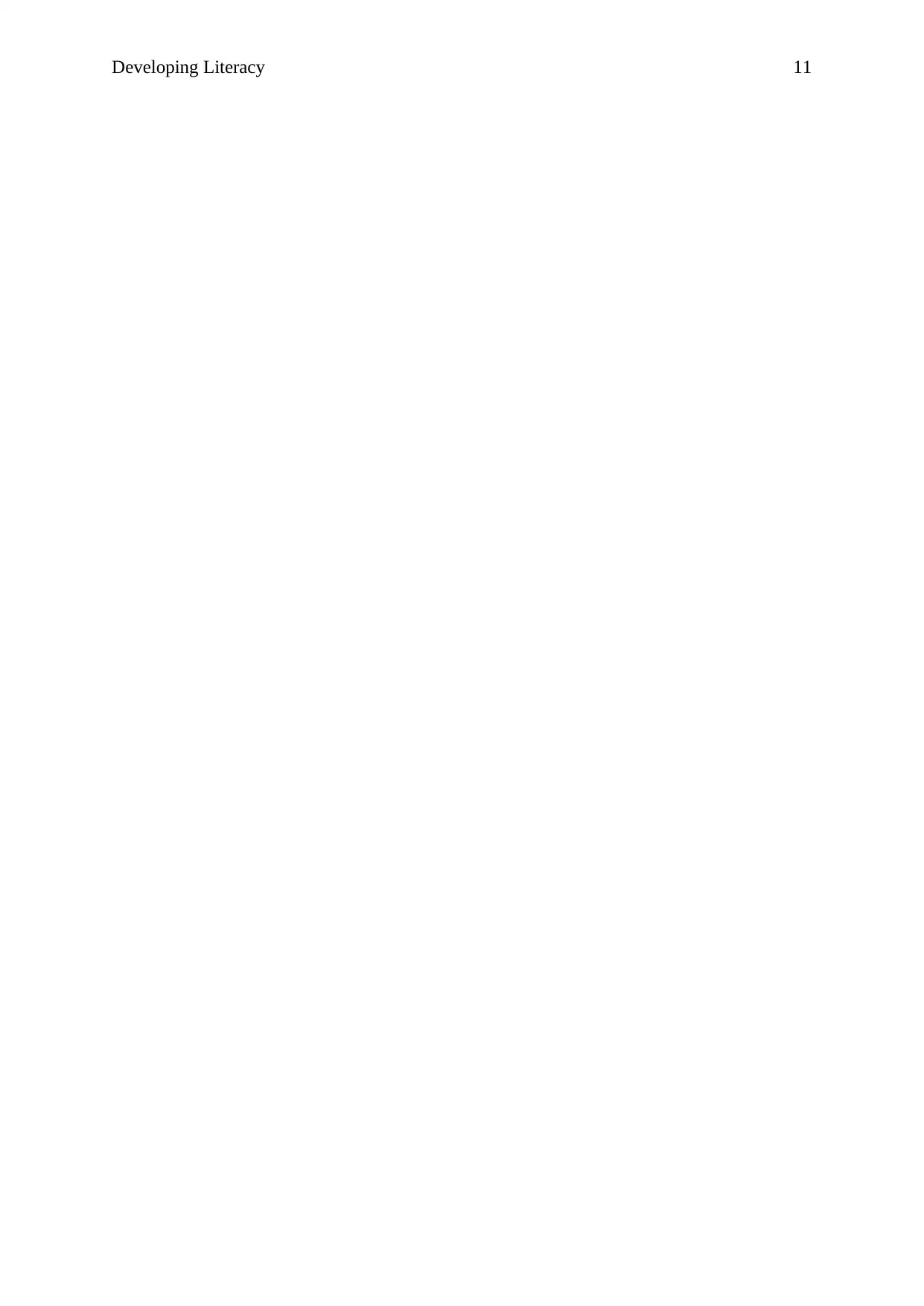
Developing Literacy 11
⊘ This is a preview!⊘
Do you want full access?
Subscribe today to unlock all pages.

Trusted by 1+ million students worldwide
1 out of 12
Related Documents
Your All-in-One AI-Powered Toolkit for Academic Success.
+13062052269
info@desklib.com
Available 24*7 on WhatsApp / Email
![[object Object]](/_next/static/media/star-bottom.7253800d.svg)
Unlock your academic potential
Copyright © 2020–2025 A2Z Services. All Rights Reserved. Developed and managed by ZUCOL.





